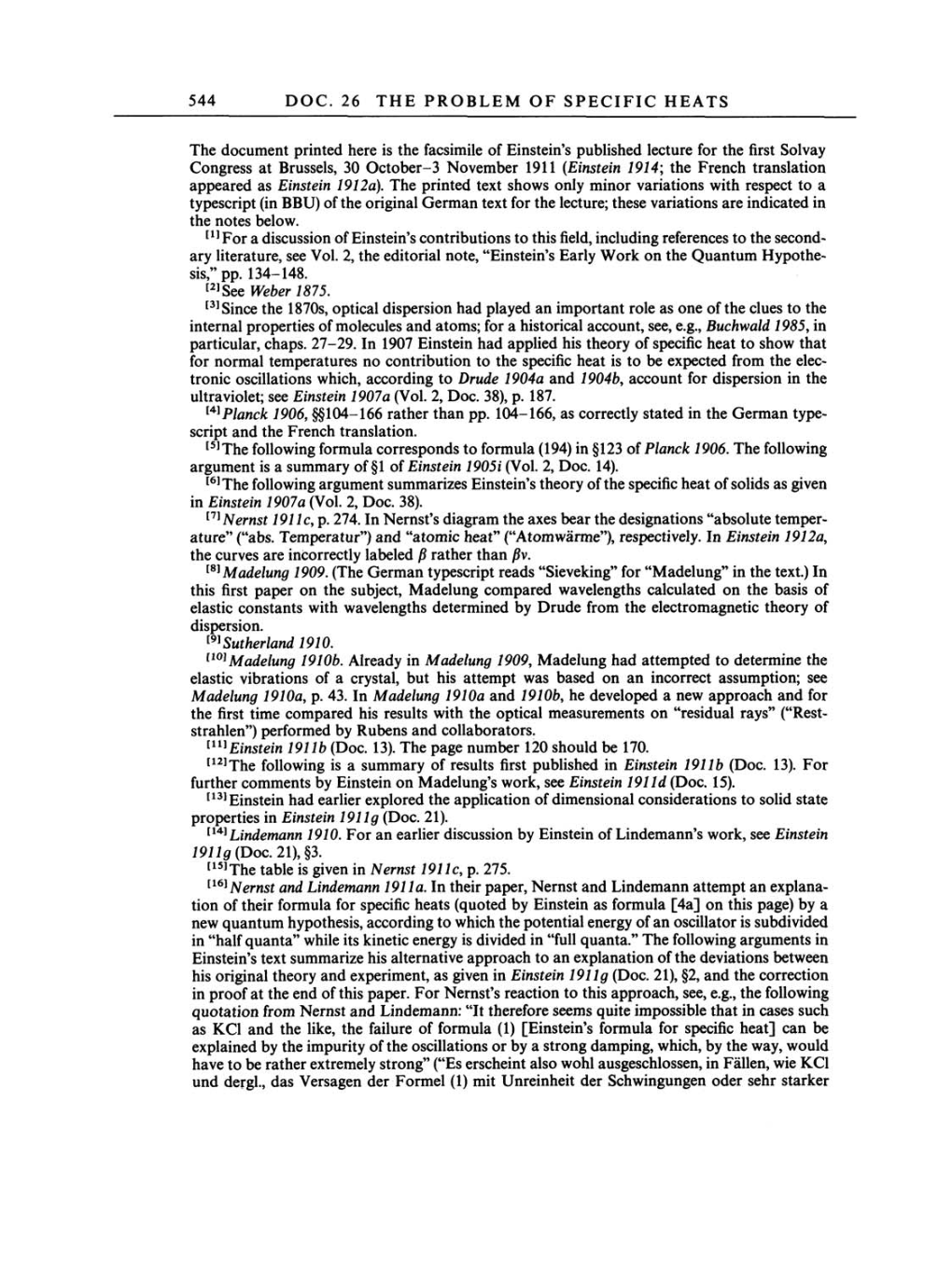544
DOC.
26 THE
PROBLEM OF SPECIFIC HEATS
The document
printed
here
is
the
facsimile
of Einstein's
published
lecture for the first
Solvay
Congress
at
Brussels,
30
October-3
November
1911
(Einstein 1914;
the French translation
appeared as
Einstein
1912a).
The
printed text
shows
only
minor variations with
respect to
a
typescript
(in
BBU)
of
the
original
German
text
for the
lecture;
these variations
are
indicated
in
the
notes below.
[1]For
a
discussion of Einstein's contributions
to
this
field,
including
references
to
the second-
ary
literature,
see
Vol.
2,
the editorial
note,
"Einstein's
Early
Work
on
the
Quantum Hypothe-
sis," pp.
134-148.
[2]See
Weber 1875.
[3]Since
the
1870s,
optical dispersion
had
played
an
important
role
as one
of
the clues to
the
internal
properties
of
molecules
and
atoms;
for
a
historical
account, see,
e.g.,
Buchwald
1985,
in
particular, chaps.
27-29. In
1907
Einstein had
applied
his
theory
of
specific
heat to
show that
for normal
temperatures
no
contribution
to
the
specific
heat
is to be
expected
from the
elec-
tronic oscillations
which,
according
to
Drude
1904a
and
1904b,
account
for
dispersion
in
the
ultraviolet;
see
Einstein
1907a
(Vol.
2,
Doc.
38), p.
187.
[4]Planck
1906, §§104-166
rather than
pp.
104-166,
as correctly
stated
in
the German
type-
script
and the French translation.
[5]The following
formula
corresponds
to formula
(194)
in
§123
of Planck
1906.
The
following
argument is
a
summary
of
§1
of Einstein
1905i
(Vol. 2,
Doc.
14).
[6]The
following argument
summarizes Einstein's
theory
of
the
specific
heat of
solids
as given
in Einstein 1907a
(Vol.
2,
Doc.
38).
[7]Nernst
1911c,
p.
274.
In Nernst's
diagram
the
axes
bear the
designations
"absolute
temper-
ature"
("abs.
Temperatur")
and "atomic heat"
("Atomwärme"),
respectively.
In Einstein
1912a,
the
curves
are incorrectly
labeled
ß
rather than
ßv.
[8]Madelung
1909.
(The
German
typescript
reads
"Sieveking"
for
"Madelung"
in
the
text.)
In
this first
paper
on
the
subject, Madelung compared wavelengths
calculated
on
the basis of
elastic constants
with
wavelengths
determined
by
Drude from the
electromagnetic
theory
of
dispersion.
[9]Sutherland
1910.
[10]Madelung
1910b.
Already
in Madelung
1909, Madelung
had
attempted to
determine the
elastic vibrations of
a crystal,
but
his
attempt
was
based
on
an
incorrect
assumption; see
Madelung 1910a,
p.
43.
In
Madelung
1910a
and
1910b,
he
developed
a new
approach
and for
the first time
compared
his
results with the
optical measurements
on
"residual
rays" ("Rest-
strahlen") performed
by
Rubens and collaborators.
[11]Einstein
1911b
(Doc.
13).
The
page
number
120
should be
170.
[12]The
following
is
a
summary
of results first
published
in
Einstein
1911b
(Doc.
13).
For
further comments
by
Einstein
on Madelung's
work,
see
Einstein
1911d
(Doc.
15).
[13]Einstein had earlier
explored
the
application
of dimensional considerations
to
solid
state
properties
in
Einstein
1911g (Doc.
21).
[14]Lindemann
1910.
For
an
earlier discussion
by
Einstein of Lindemann's
work,
see
Einstein
1911g (Doc.
21),
§3.
[15]The
table is
given
in
Nernst
1911c,
p.
275.
[16]Nernst
and
Lindemann
1911a.
In their
paper,
Nernst and Lindemann
attempt an explana-
tion of their formula for
specific
heats
(quoted by
Einstein
as
formula
[4a]
on
this
page)
by
a
new
quantum hypothesis,
according
to which the
potential energy
of
an
oscillator is
subdivided
in
"half
quanta"
while
its kinetic
energy
is divided in "full
quanta."
The
following arguments
in
Einstein's
text
summarize his alternative
approach to
an
explanation
of
the
deviations between
his
original theory
and
experiment, as given
in
Einstein
1911g
(Doc.
21), §2,
and
the correction
in
proof
at
the end of this
paper.
For
Nernst's reaction to this
approach,
see, e.g.,
the
following
quotation
from Nernst and Lindemann: "It therefore
seems
quite impossible
that in
cases
such
as
KCl and the
like,
the failure of formula
(1)
[Einstein's
formula for
specific
heat] can be
explained
by
the
impurity
of
the
oscillations
or
by
a
strong damping,
which,
by
the
way,
would
have
to
be rather
extremely strong"
("Es
erscheint also wohl
ausgeschlossen,
in Fällen, wie
KCl
und
dergl.,
das
Versagen
der
Formel
(1)
mit Unreinheit der
Schwingungen
oder sehr starker
